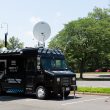FirstNet Authority seeks input on potential solutions to off-network challenges
FirstNet Authority officials released a request for information (RFI) seeking input about direct-mode and other technological solutions to address the issue of providing broadband communications support “off-network”—when first responders are in a location not supported by FirstNet’s terrestrial macro LTE system.
“We’re looking beyond the horizon—how does this look going forward?—and pulling that into the nationwide public-safety broadband network for that device-to-device connectivity,” FirstNet Authority Chief Technology Officer (CTO) Jeff Bratcher said during an interview with IWCE’s Urgent Communications.
“This RFI is focused on any type of technology for device-to-device [communications]. It could leverage 3GPP standards for other mechanisms, [but] we’re not limiting it to 3GPP for this.”
Indeed, the RFI document—entitled “Next Generation Off-Network Communications”—emphasizes the FirstNet Authority’s desire to receive information from any source or about technologies or approaches that potentially could help solve one of public safety longstanding communications issues.
“Respondents should not be constrained by perceived or assumed ‘requirements,’ nor should respondents be constrained by preconceived ideas of what off‐network functionality is today,” according to the RFI document.
“The Authority is interested in any work that your organization has ongoing pertinent to off‐network technologies and/or solutions for first responders and may include applied research as it pertains to future product-development possibilities; new product design, development and test; prototype work; and/or pilots and demonstrations of potential solutions.”
Questions from potential respondents about the RFI are due on Sept. 1, while the responses are due on Sept. 30, according to the RFI document.
Public-safety broadband has gained traction in the U.S., with FirstNet now boasting more than 2.5 million connections with first-responder agencies. Where coverage exists, prioritized LTE performance from FirstNet and Verizon has received plaudits from public safety, which has used the new level of broadband reliability to explore new applications—many of which are cloud-based—that would not have been considered even five years ago.
But arguably the biggest technological issue for public safety is what happens when users cannot access an LTE network, because the coverage doesn’t exist or was compromised by a natural or man-made incident.
In the land-mobile-radio (LMR) arena, users can switch their radios to a direct-mode setting—sometimes referenced as a “simplex,” “walkie-talkie” or “talkaround” capability—and speak with colleagues. With many LMR radios having large external antennas, benefiting from better propagation from VHF spectrum and operating at power levels of up to 3 watts or 5 watts, this LMR direct-mode functionality can support communication range for miles, in the right environments.
Duplicating this off-network performance with LTE has proven to be challenging, and many industry sources question whether physics will ever allow it, noting that most LTE devices have internal antennas and are prohibited from operating at power levels above 0.25 watts.
Part of the LTE standard includes Proximity Services (ProSe) which was designed to support direct-mode communications for voice, data and video. However, many in the industry are calling for other direct-mode solutions, because most chipsets do not support ProSe. Samsung has a ProSe-capable chipset that works, but the range is not as great as public-safety users have with LMR.
Bratcher said many lessons learned from ProSe are being leverage in the development of vehicle-to-everything (V2X) technologies that are expected to provide foundational communications for autonomous cars in the future.
“We’re curious to see those types of technologies and how they could benefit public safety for this off-network capability,” Bratcher said.
While progress in providing device-to-device communications in the LTE arena has been limited, the ability to provide first responders with LTE coverage in otherwise off-network scenarios has expanded tremendously in recent years. In addition to traditional deployables like SatCOLTs, there are numerous “bring the network with you”—many housed in Pelican cases or backpacks—that are designed to help address the communications needs of the initial wave of responders to an incident that occurs outside of the terrestrial network coverage area.
In addition, the satellite industry is evolving rapidly, with thousands of low-earth-orbit (LEO) satellite being launched annually by a variety of companies. Some LEO offerings promise to provide high-throughput, low-latency connectivity with the help of a satellite antenna, while two LEO companies—Lynk and AST SpaceMobile—have announced plans to have their satellites connect directly with existing smart devices, effectively acting as LTE towers in space that use carrier’s sub-1 GHz spectrum.
Bratcher said the FirstNet Authority is interested in getting information about as many options as possible.
“We would love to hear from some of them,” Bratcher said when asked about the LEO satellite capabilities. “[The RFI is] more focused on device-to-device [communications], but we wouldn’t preclude reading their information, if they choose to respond, that’s for sure.”
While much of the off-network focus to date has been focused on voice communications, Bratcher emphasized that the FirstNet Authority hopes the RFI gathers responses that also address broadband communications that support data and video applications.
With AT&T more than 90% complete with the initial contracted buildout of FirstNet, Bratcher said the off-network RFI is the first in series of RFIs that the FirstNet Authority will release as the organization contemplates how to improve the nationwide public-safety broadband network (NPSBN) in the future. Bratcher noted that the RFI-based strategy is not new, as the FirstNet Authority issued 13 RFIs that were used to help inform the 2016 request for proposal (RFP) that resulted in AT&T being awarded the FirstNet contract in March 2017.
Findings from the RFIs are expected to be incorporated into the FirstNet Authority’s Roadmap, which is an ever-evolving document that helps guide the FirstNet Authority board’s decisions about reinvesting about $15 billion into the FirstNet system.
Under the 2012 law that established the FirstNet Authority, the FirstNet system is supposed to be a financially self-sustaining network, even though Congress provided just $7 billion for a project that experts estimated would cost more than $50 billion to build.
But the FirstNet Authority effectively assured its financial security by signing its contract with AT&T in March 2017 after completing a procurement process. The 25-year deal provides AT&T with access to the 20 MHz of prime 700 MHz spectrum licensed to the FirstNet Authority as well as potentially $6.5 billion—paid in phases, as AT&T meets network-deployment benchmarks—in funds generated from FCC spectrum auctions several years ago.
In return, AT&T is responsible for building and maintaining the NPSBN and making annual payments totaling $18 billion to the FirstNet Authority over the 25-year period of the contract. Of this $18 billion in AT&T payments, about $3 billion is expected to fund FirstNet Authority operations, and about $15 billion is slated to fund enhancements to the FirstNet system.
In December 2019, the FirstNet Authority board approved using the first $218 million of this reinvestment money to initiate the FirstNet core upgrade to support 5G services and to purchase additional deployable assets. No specifics were provided about exactly how much funding was allocated to each purpose, but most of the money was directed to the first phase of the 5G upgrade, according to sources.

















